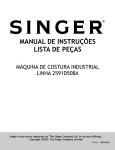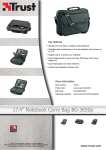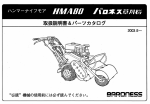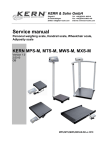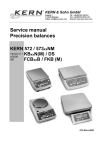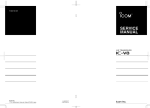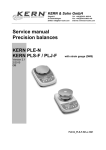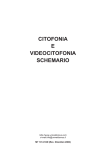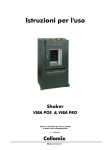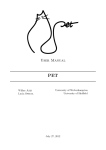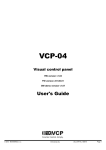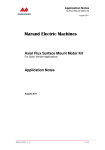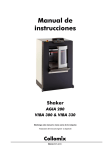Download PEJ-PES Version 1.1
Transcript
KERN & Sohn GmbH Ziegelei 1 D-72336 Balingen E-Mail: [email protected] Tel: +49-[0]7433- 9933-0 Fax: +49-[0]7433-9933-149 Internet: www.kern-sohn.com Service manual Precision balance KERN PEJ/PES Version 1.1 4/2009 GB PEJ/PES-SH-e-0911 GB KERN PEJ/PES Version 1.1 4/2009 Service manual Precision balance Contents 1. 2. 3. Basic information................................................................................................. 3 Total View............................................................................................................ 4 Electronic Construction........................................................................................ 5 3.1 Block Diagram .............................................................................................. 5 3.2 Whole Wiring ................................................................................................ 6 4. Troubleshooting................................................................................................... 7 4.1 Troubleshooting Procedure .......................................................................... 7 4.2 Troubleshooting Table.................................................................................. 8 4.3 Troubleshooting Table 2............................................................................... 9 4.4 Primary Checks .......................................................................................... 10 4.5 Checks for Electric/Electronic Parts ........................................................... 11 4.5.1 Check of VIBA-2A board ..................................................................... 13 5. Adjustment and Setting ..................................................................................... 14 5.1 Span Calibration (Adjustment with internal weight – PEJ).......................... 14 5.2 Span Calibration (Adjustment with external weight – PES) ........................ 15 5.3 Corner Error Adjustment ............................................................................ 16 5.4 Linearity Adjustment................................................................................... 17 5.4.1 Table Increasing Calibration Weight for Linearity Adjustment ............. 18 5.5 Calibration of Built-In Weight (Ref Cal) – only PEJ..................................... 19 6. Parts Replacement ............................................................................................ 20 6.1 How to Remove the Case .......................................................................... 20 6.2 How to Cover the Case .............................................................................. 20 6.3 How to Replace Mechanical Unit ............................................................... 21 6.4 How to Remove Mechanical Unit ............................................................... 21 6.5 How to Install Mechanical Unit ................................................................... 22 6.6 Sequence of Tuning-Fork Sensor Replacement ........................................ 23 6.7 How to Remove Tuning-Fork Assy............................................................. 23 6.8 How to Install Tuning-Fork Assy................................................................. 24 6.9 Adjustment of Overload Stopper ................................................................ 25 6.10 Sequence of Circuit Board Replacement ................................................... 26 7. Installation of Options ........................................................................................ 27 7.1 Installation of Battery Option ...................................................................... 27 7.2 Installation of Relay Contact Option ........................................................... 28 8. Parts List ........................................................................................................... 30 8.1 Explosion Diagram ..................................................................................... 30 8.2 Bill of Material............................................................................................. 31 8.3 View of Components PES 31000-1M ......................................................... 32 2 PEJ/PES-SH-e-0911 1. Basic information Grundlegende Hinweise The device must be repaired only by trained specialist staff or personnel with professional formation (such as a repair-specialist accredited by law concerning verification). The service manual is obligatory for repair work. After repair, original conditions of the device have to be restored. Only original spare parts should be used. Instructions about conformity-evaluated scales: Repair must be carried only at 100% compliance with the type approval. A violation of this specification will result in a loss of the type approval! After successful repair the balance will have to be reverified before it can be used again in a statutorily regulated field. Das Gerät darf nur von geschultem oder beruflich ausgebildetem Fachpersonal (z. B. eichrechtlich anerkannter Instandsetzer) repariert werden. Die Serviceanleitung ist bindend für Reparaturen. Das Gerät muss nach erfolgter Reparatur wieder in den Originalzustand zurückversetzt werden. Es dürfen nur Originalersatzteile verwendet werden. Hinweis zu konformitätsbewerteten Waagen: Reparatur darf nur in 100% -iger Übereinstimmung mit der Bauartzulassung erfolgen. Ein Verstoß gegen diese Vorgabe führt zum Erlöschen der Bauartzulassung! Nach erfolgreicher Reparatur muss eine Nacheichung erfolgen, um die Waage wieder im gesetzlich geregelten Bereich verwenden zu können. PEJ/PES-SH-e-0911 3 2. Total View 4 PEJ/PES-SH-e-0911 3. Electronic Construction 3.1 .1 Block Diagram Calibration Weight Unit (PEJ only) BT PRINT PEJ/PES-SH-e-0911 LEFT 5 3.2 Whole Wiring Calibration Weight Unit (PEJ only) PRINT 6 LEFT PEJ/PES-SH-e-0911 4. Troubleshooting 4.1 Troubleshooting Procedure LF Board is normal Board DP (N) Board PEJ/PES-SH-e-0911 LF Board LF Board 7 4.2 Troubleshooting Table SYMPTOMS No display lights on ‘u-Err’ or ‘o-Err’ appears self test of segment. 1. 2. 3. 4. 1. 2. 3. 4. 5. Display does not get settled down. Display does not repeat correctly. 1. 2. 3. 4. 5. Zero points drifts. 6. ‘o-Err’ appears with a net load less than specified capacity. 1. 2. 3. 4. Span is out of specified range. 5. 1. 2. 3. 4. Linearity is out of specified range. 1. 2. 3. 4. 8 CAUSES & REMEDY DP board is defective. AC adaptor is defective. Wrong connection of connection cords inside. Built-in battery is discharged. Wrong weighing pan is applied. Tuning-fork sensor or mechanism unit is defective. DP board is defective. Setting of address date has mistake. Coefficient memories (address data) have changed by noise or static electricity. Adjust linearity. Some parts such as stopper touch others. Internal calibration weight touches other parts. Weighing pan touches other parts. Foreign substances are in the scale. Tuning-fork sensor or mechanism unit is defective. Affected by wind or disturbing oscillation. Check environment or working base. Check also setting of stabilization time. Gross weight applied to the scale pan (net weight + tare value) exceeds the scale capacity. Setting of address data has mistake. Coefficient memories (address data have changed by noises or static electricity. Adjust linearity. Wrong external calibration weight is used in span calibration. Internal calibration weight touches other parts. Tuning-fork sensor or mechanism unit is defective. DP board is defective. Setting of address data has mistake. Coefficient memories (address data) have changed by noises or static electricity. Adjust linearity. Tuning-fork or mechanism unit is defective. Setting of address data has mistake. Coefficient memories (address data) have changed by noises or static electricity. Adjust linearity. Wrong external calibration weight is used in span calibration. PEJ/PES-SH-e-0911 4.3 Troubleshooting Table 2 SYMPTOMS - Corner error is too much. - Display suddenly disappeared appears. - appears. - appears. - appears. - appears. appears. - appears. - appears. - appears. - appears. - appears. PEJ/PES-SH-e-0911 CAUSES & REMEDY 1. Mechanical unit is defective, such as roberval plate (spring) has been bent or twisted. 2. Pan base touches other parts. 1. DP board is defective. 2. AC adaptor is defective. 1. Wrong external calibration weight is used in span calibration. (External weight is less than 50% of capacity). 1. Span error exceeds 1% of capacity in span calibration (check the external weight). 2. Tuning-fork sensor or mechanical unit is defective. Something is loaded on the pan in automatic span calibration (remove the things from the pan). 1. Span error exceeds 1% of capacity in automatic span calibration. 2. Tuning-fork sensor or mechanical unit is defective. Interval time is not properly set. Automatic span calibration stops due to battery consumption. The weight error exceeds +/- 100.00mg. Re-set the weight error within +/- 100.00mg. Coefficient memories (address data) have changed. Reset the data. Internal clock function is defective. Check internal clock and replace DP board, if necessary. Coefficient memories (address data) have changed. Check the address data and reset it, if necessary. The weight of sample is too light (counting mode and % mode). Counting function is not properly operated. 9 4.4 Primary Checks 1. Is any wind around the site? Is any oscillation? Is the working table stable? 2. Is anything under the pan base or the weighing pan? 3. Is the weighing pan the right one? 4. Is AC adaptor connected both with the scale and with the scale and with the outlet properly? 5. Is battery option charged sufficiently? 10 PEJ/PES-SH-e-0911 4.5 Checks for Electric/Electronic Parts PEJ/PES-SH-e-0911 11 1. 2. Check of input voltage TP0 – CN1- +12V~+14V Power voltage in the circuit TP0 – TP1 +4.75V~+5.25V TP0 – IC13-O +9.5V~+10.5V TP0 – D13 anode +3.7V~+4.3V TP0 – D10 cathode +23.5V~+24.5V 3. Check of signal wave TP0 – TP3 (tuning-fork waveform) TP0 – TP4 (temperature waveform) D13 anode – IC11-6pin (VFD filament frequency) VFD1-1 pin – 56 pin 12 PEJ/PES-SH-e-0911 4.5.1 Check of VIBA-2A board 1. Preparation for checks Prepare the oscilloscope. Turn off the scale and connect probe to CN2. CH – 1 → (1) GND → (2) CH – 2 → (3) Voltage and Frequency range of oscilloscope. • Voltage Range CH – 1 → 0.1~0.5V/DIV. CH – 2 → 1V/DIV. • Frequency Range 0.2m sec/DIV. CN 1 1. 2. 3. 4. 5. 6. Power Source +4V - +6V GND Power Source -4V - -6V Rectangular Wave Output (tuning-fork) GND Rectangular Wave Output (temperature) 2. How to Check (1) Vibration starts in 3 seconds after turning on the switch of scale. (2) Check the amplitude and phase difference of CH-1 and CH-2 as ½ of full capacity is loaded. E -amplitude (P-P) … CH-1 → more than 150mV (average: 750mV) CH-2 → more than 700mV (average: 3.5V) - (phase difference) … 15~120° /T:0.3~0.8 division (0.2msec/DIV.) PEJ/PES-SH-e-0911 13 5. Adjustment and Setting 5.1 Span Calibration (Adjustment with internal weight – PEJ) The installed adjusting weight allows checking and resetting the weighing accuracy at any time. Procedure for adjustment (according to the operating instructions): Observe stable environment conditions. A warming-up time of approx. 2 hours for stabilisation is necessary. Setting: 7. CA. "1" Operation Switch on the balance using the Press Display -key -key, [Auto CAL] is displayed. Auto CAL Automatic adjustment is started. CAL Calibration will be carried out automatically. CH. 0 CAL CH. Calibration process has been concluded. 14 F5 End PEJ/PES-SH-e-0911 5.2 Span Calibration (Adjustment with external weight – PES) Procedure for adjustment (according to the operating instructions): Observe stable environment conditions. A warming-up time of approx. 2 hours for stabilisation is necessary. Setting: 7. CA. "3" Operation Switch on the balance using the Press Display -key -key. Zero point will be saved. Carefully place adjusting weight in the centre of the weighing plate Adjustment process is started. The process of adjustment is completed. Remove adjusting weight, balance will return into weighing mode automatically. In case of an adjustment error or incorrect adjusting weight the display will show [- Err]; repeat adjustment process. PEJ/PES-SH-e-0911 15 5.3 Corner Error Adjustment 1. Remove the case, then after setting the pan base and the pan, turn the adjuster legs to bring the bubble of the level to the center of the circle. 2. Push nylon rivet from the inside and remove the rear shutter. 3. Load full scale weight and push T key. Check the corner error referring to the diagram below. Adjusting Bolt (A) Adjusting Bolt (B) Rear shutter Nylon rivet : The error is positive to the center. : The error is negative to the center. : Drive the bolt counter-clockwise. : Drive the bolt clockwise. Corner Error Adjusting Diagram: 16 PEJ/PES-SH-e-0911 5.4 Linearity Adjustment Set the verification switch to unlocked before doing the linearity adjustment (see drawing). Prior to verification, the verification switch must be moved into the verification position. • Position forwards: enabled (unlocked) • Position backwards: verification position Position verification switch While pressing both keys when + , press to ON. Release both appears (maintenance mode). After a while, display changes to weight value. Press appears after displaying . Press first and press until together and release both. display starts blinking to indicate zero adjusting is performed automatically. Put the weight referring to the table at the next page Returns to weight value after reading Press to turn off Power and press normal weighing mode. PEJ/PES-SH-e-0911 . again. Then return to 17 5.4.1 Table Increasing Calibration Weight for Linearity Adjustment Model 220 g 420 g 620 g 2200 g 0g 50 g 100 g 150 g 220 g 0g 100 g 200 g 300 g 420 g 0g 150 g 300 g 450 g 620 g 0g 500 g 1000 g 1500 g 2200 g 50 g x 4 20 g x 1 100 g x 4 20 g x 1 100 g x 4 50 g x 4 20 g x 1 500 g x 4 200 g x 1 4200 g 6200 g 8200 g 15000 g 0g 100 g 0 2000 g 3000 g 4200 g 0g 1500 g 3000 g 4500 g 6200 g 0g 2000 g 4000 g 6000 g 8200 g 0g 3000 g 7000 g 11000 g 15000 g 1000 g x 4 200 g x 1 1000 g x 4 500 g x 4 200 g x 1 2000 g x 4 200 g x1 2000 g x 7 1000 g x 1 Display Calibration Weight Required Model Display Calibration Weight Required *Please use the weight for F1 or higher class to maintain the accuracy. 18 PEJ/PES-SH-e-0911 5.5 Calibration of Built-In Weight (Ref Cal) – only PEJ Set the verification switch to unlocked before doing the calibration of built-in weight (see drawing). Prior to verification, the verification switch must be moved into the verification position. • Position forwards: enabled (unlocked) • Position backwards: verification position Position verification switch 1 + While pressing both both keys when , press to ON. Release appears. 2 After a while, display changes to weight value. Press , is displayed. 3 first and Verify that no load is on the pan. Press press key together and release both. display starts to blinking to indicate zero adjustment is performed automatically. 4 When Zero adjustment is completed, display advances to [on F5], indicating the span adjustment is ready to start. 5 Load the reference weight. Display starts blinking to adjust the span automatically. 6 The calibration is finished and display stops blinking, then automatically returns to weighing mode. 1. It is recommended to use a weight of full scale capacity for accurate calibration (max. load). 2. Error messages: : The reference weight is over than the full capacity. : The reference weight is less than ½ of the capacity. : The data error exceeds 1% of the capacity. 3. It is recommended to use reference calibration weight of better accuracy than the scale. PEJ/PES-SH-e-0911 19 6. Parts Replacement 6.1 How to Remove the Case 1. Remove pan and pan base. 2. Remove three screws fixing the case. M4 x 8 Screws M3 x 15 Screw 6.2 How to Cover the Case 1. Cover the case 2. Fixing the case with screws 3. Put the pan base and the pan. 20 PEJ/PES-SH-e-0911 6.3 How to Replace Mechanical Unit Mechanical Unit is defective ↓ Replace Mechanical Unit ↓ Reset address data (data of replacing mechanical unit) ↓ Span Calibration ↓ Adjust the overload stopper ↓ Performance Check 6.4 How to Remove Mechanical Unit 1. Remove the case. 2. Remove the cords (black and white) of tuning-fork assy from VIBA board assy (remove the solder). 3. Remove nylon cramp fixing cords of tuning-fork assy. Cord of tuning-fork assy (black) (white) Nylon cramp 4. Remove four bolts fixing mechanical unit. 5. Remove the mechanical unit from the chassis. PEJ/PES-SH-e-0911 21 M5 x 20 bolt 6.5 How to Install Mechanical Unit 1. Put the mechanical unit on the chassis (take care to put radiation shield between the chassis and the mechanical unit. 2. Solder the cords of tuning-fork sensor to VIBA board assy (black cord to “1” and white cord to “3”, referring to the picture below. 3. Fix the cords of tuning-fork sensor with nylon cramp (be sure these cords are not touch with other parts). 4. Cover the case. black cord white cord nylon cramp 22 PEJ/PES-SH-e-0911 6.6 Sequence of Tuning-Fork Sensor Replacement Tuning-Fork sensor is defective. ↓ Replace Tuning-Fork sensor. ↓ Linearity adjustment ↓ Adjust the overload stopper ↓ Performance check 6.7 How to Remove Tuning-Fork Assy 1. Remove the mechanical unit from the chassis. 2. Remove the sub-pan base assy by loosing three screws on the mechanical unit. 3. Loose two screws to remove tuning-fork assy. 4. Replace tuning-fork assy. Three screws fixing sub-pan base assy tuning-fork assy PEJ/PES-SH-e-0911 two screws fixing tuning-fork assy 23 6.8 How to Install Tuning-Fork Assy 1. Temporarily fix tuning-fork assy to mono-metal block. 2. Fix sub-pan base assy to mono-metal block with screws (torque: 52.5kgfcm). 3. Tightly fix tuning-fork assy with screws while putting the weight (10kg) on the sub-pan base assy (torque: 30kgfcm). sub-pan base fixing screws (three) tuning-fork assy tuning-fork fixing screws (two) Weight 10kg Torque: 30kgfcm 24 PEJ/PES-SH-e-0911 6.9 Adjustment of Overload Stopper 1. Fix the pan base assy to the mechanical unit and put the square pan on it. 2. Connect AC adaptor and turn on the switch. 3. Change to maintenance mode. 4. Adjust the overload stopper. Square pan Jig to adjust the stopper [Adjusting procedure] 1. Remove the pan and the pan base. 2. Push TARE key to display [0.0.0.]. 3. Put the clearance gauge between the adjusting screw and the chassis, then adjust the stopper. 4. After adjusting the stopper, check the overload-error value in referring to the table below. Capacity 2200 g 4200 g 6200 g 8200 g 15000 g PEJ/PES-SH-e-0911 Overload stopper adjustment 6000 ~ 7000 g 6000 ~ 7000 g 9500 ~ 11500 g 18500 ~ 20000 g 24000 ~ 26000 g Capacity Clearance 2200 g 4200 g 6200 g 8200 g 15000 g 0.2 0.2 0.2 0.35 0.4 25 6.10 Sequence of Circuit Board Replacement [How to Remove DP (N) Board] 1. Open the case. Remove SW spacer and key spacer from DP (N) board. 2. Loose four screws from DP (N) board. 3. Take off the connectors of CN1, CN3 and CN4 on DP (N) board. SW spacer Key spacer DP (N) board fixing screws (four) [How to Install DP (N) Board] 1. Connect the connectors to DP (N) board. CN1: LFM board assy cord CN3: Tuning-fork assy cord CN4: RS Board assy cord 2. Fix DP (N) board with screws. 3. Fix SW spacer and key spacer. CN4 Key Spacer CN1 CN3 This projection should be on right lower side. 26 PEJ/PES-SH-e-0911 7. Installation of Options 7.1 Installation of Battery Option 1. 2. 3. 4. 5. Remove the case. Fix battery assy to the chassis with two screws. Fix cords of BT board assy with nylon cramp and two screws. Connect the cord of BT board assy to CN2 of DP (N) board. Put “BATTERY” label on the AC adaptor. Battery Assy M4 screws CN2 connector PEJ/PES-SH-e-0911 27 7.2 Installation of Relay Contact Option 1. Remove the case. 2. Fix LM board assy to the chassis with two screws. M3 x 10 screws 28 PEJ/PES-SH-e-0911 3. Fix cords of LM board assy with LCD packing and connect the cords to CN7 of display board. 4. Put RELAY label. CN 7 LCD packing RELAY label PEJ/PES-SH-e-0911 29 8. Parts List 8.1 Explosion Diagram 30 PEJ/PES-SH-e-0911 8.2 Bill of Material POS. NO. DESCRIPTIONS PARTS NO. Q'TY REMARKS 1 2 3 4 5 6 7 8 9 10 11 12 13 14 15 16 17 18 19 20 20-1 20-2 20-3 21 22 23 24 25 26 27 28 29 29-1 30 31 32 33 34 35 36 36-1 36-2 37 38(A) 38(B) CHASSIS ADJUSTER HOLE PLUGDP-312 SHUTTER DP PCB SUPPORT PLATE LCD SPACER LCD PACKING LEVEL ASSY RS232C PCB ASSY RS BLIND RS BRACKET PCB SPACER FOR RS232 RS SUTTER RS PACKING REAR SHUTTER NYLON RIVET NRP-355 LF PCB ASSY LF PCB SUPPORT PLATE LF COVER DP(N) PCB ASSY VFD DISPLAY TACT SWITCH SLIDE SWITCH SW SPACER KEY SPACER TF SENSOR CODE VIBA-2A (3) Assy VIBA STAY PCB SPACER FOR VIBA-2A NYLON CLAMP NK-2N HEAT SHUTTER PLATE MECHANICAL UNIT TUNING FORK SENSOR ASSY SUB PAN BASE ASSY UPPER CASE DISPLAY PANEL SHEET SWITCH PANEL SHEET DUST COVER PROTECTOR PAN BASE ASSY PAN GUIDE M-1064 SQUARE PAN AC ADAPTER, AC230 IN/DC12V OUT AC ADAPTER, AC120 IN/DC12V OUT 220012I 200034I 110002J 3190P 220072P 3650P 7398P 3120A 22AE053 220062P 220069P 3166C 220073P 220090P 220066P 22CN0L3 22AE055 220071P 220032P 22AE06 22OE003 22SW001 11SW002 220015I 220016I 22AE056 IH008 22AE70P 3166C11 OM007 220068P PEJ/PES-SH-e-0911 22006A 220011I 220063P 220064P 220014I 220065P 220063A 3071I 22OM014 220067P UM083 UM092 1 4 1 1 1 1 1 1 1 1 1 2 1 1 1 2 1 1 1 1 1 1 10 1 1 1 1 1 1 2 1 1 1 1 1 1 1 1 1 1 4 1 1 1 1 for RS232 PCB with rear shutter (220066P) for VIBA-2A(3) PCB 31 8.3 View of Components PES 31000-1M 32 PEJ/PES-SH-e-0911
































